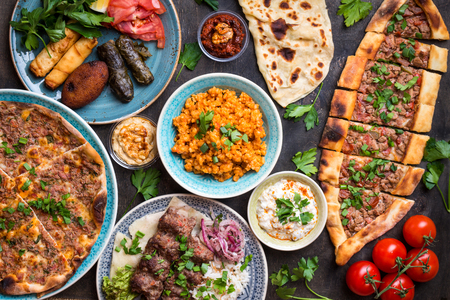Arabic Food Unveiled: 10 Dishes, 7 Culinary Insights

Arabic Food Unveiled: 10 Dishes, 7 Culinary Insights Middle Eastern culinary allure has become a mainstay in Western culture. From ubiquitous kebab shops in most towns to the widespread availability of hummus in quality grocery stores, Middle Eastern cuisine has solidified its presence. This article endeavors to provide a comprehensive understanding of the intricate tapestry that is Middle Eastern gastronomy. Diverse Flavors, Multifaceted Origins The essence of Middle Eastern cuisine manifests in a symphony of bold and intricate flavors, encompassing the spectrum from sweet and savory to spicy and tangy. The ingredients employed are equally diverse, featuring a harmonious blend of fresh vegetables, herbs, spices, grains, and legumes. Let us delve into: The historical roots of Middle Eastern Cuisine, tracing back to ancient influences from Iranian, Egyptian, Syrian, and Mesopotamian cultures. A curated list of exemplary dishes representing various Middle Eastern subcultures, including kofta, baklava, and manakeesh. Unveiling the etiquettes and traditions essential for an authentic Middle Eastern dining experience. Tradition Redefined: Beyond Halloumi and Falafel Situated at the crossroads of Europe, Asia, and Africa, the Middle East is a cultural melting pot, resulting in a delightful fusion of culinary traditions. The Levant, a substantial part of the Middle East, stretching from Africa to Eurasia along the eastern Mediterranean, encompasses nations like Syria, Jordan, Palestine, Israel, and Lebanon. Mezze, a hallmark of Levantine dining, mirrors the Spanish tapas style, presenting an array of small dishes. A typical mezze spread boasts hummus, falafels, olives, pita breads, and dolma, among other delicacies. For the uninitiated, dolma, a topic we’ll explore later, adds an intriguing layer to this gastronomic tableau. Global Influence of Arabic Gastronomy Middle Eastern cuisine doesn’t just absorb influences; it radiates its impact globally. From the bustling streets of France and the United Kingdom to the diverse culinary landscape of the United States, kebab joints have become ubiquitous. These establishments offer not only the quintessential doner kebabs but also falafels, complemented by a medley of freshly shredded salad ingredients. Hummus, tahini, tabbouleh, pickled vegetables, and tzatziki converge within a pita, crafting a delectable kebab experience. The Wellness Quotient of Middle Eastern Fare Dropping by a local doner kebab shop isn’t merely a gustatory delight for many Americans; it’s a health-conscious choice. This Middle Eastern staple has even inspired homemade wraps for clean workday lunches. This segment scrutinizes the health aspect of Middle Eastern cuisine. Vegetal Abundance and Leguminous Goodness Salads play a pivotal role in the doner kebab experience, featuring shredded iceberg lettuce, carrots, and onions. Tabouleh, another salad variety with uncooked bulgur wheat, finely chopped parsley, mint, tomato, and onion, adds a nutritious dimension to kebabs and other Middle Eastern dishes. Additionally, pickled vegetables like beetroot, cucumber, and onion contribute to the preservation of vegetables for out-of-season use. Nourished by Healthy Fats: The Ode to Olive Oil In Middle Eastern culinary realms, butter and olive oil reign supreme. Abundant ancient olive groves across Levantine landscapes provide the cherished olives and their oil, preferred not just for its health benefits but also for its superior flavor. Whether as a standalone dressing or infused with a hint of lemon juice, olive oil takes culinary excellence to new heights. Whole Grains: A Wholesome Foundation Contrary to the prevalent consumption of refined wheat products in the West, the Middle East opts for whole grains. Bulgur wheat, featured in salads and hot dishes, akin to pasta but notably healthier, sometimes graces Middle Eastern tables in its uncooked form, as seen in tabbouleh. Averse to Processed Fare: A Natural Approach Unlike Western reliance on heavily processed foods like pasta, Middle Eastern cuisine adheres to a more natural approach. This eschewal of highly processed ingredients results in dishes brimming with vital nutrients, surpassing their Western counterparts in vitamins and minerals. Moreover, the absence of artificial flavorings or preservatives allows the natural flavors of Middle Eastern dishes to shine through. Flavor Alchemy: Herbal and Spicy Elevation While Western cuisines often rely on sugary or artificially flavored sauces, Middle Eastern gastronomy showcases a masterful interplay of traditional herbs and spices. Yogurt, hummus, and tahini, simple yet rich condiments, harmonize with bold and spicy flavors. These condiments, being natural and protein-packed, eschew artificial additives. Embarking on an Arabic Food Culinary Odyssey: 10 Must-Try Dishes Arabic Food cuisine, spanning a vast geographical expanse, presents a diverse array of dishes rooted in its rich and ancient history. Turkish culinary traditions, interwoven into this tapestry, add a unique flavor profile to the overarching Arabic culinary experience. Fattoush Salad: A Crisp Symphony of Flavors Combining fried or toasted khubz (pita bread) with seasonal vegetables, turnips, cucumber, and salad greens, Fattoush Salad is a textural delight. The dressing, a medley of olive oil, lemon juice, pomegranate molasses, and sumac, introduces a delightful hint of sourness. Tabbouleh Salad: Freshness in Every Bite An uncooked bulgur wheat ensemble with finely chopped mint, parsley, tomatoes, and onions, Tabbouleh Salad adds a refreshing note to kebabs and various Middle Eastern dishes. Mainstays: Shawarma, Kebabs, and Musakhan Recognizable even in hometowns beyond the Middle East, shawarma, kebabs, and Musakhan claim the spotlight. Shawarma refers not just to thinly sliced meat on a vertical rotisserie but also to the wraps in which it’s enjoyed. Shawarma: Culinary Elegance on a Rotisserie Typically lamb or mutton slow-grilled to perfection on a rotisserie, shawarma meat, when paired with fresh salad ingredients and divine sauces, finds its consummate expression in wraps. Soups & Salads: Light Companions to Hearty Meals Soups and salads, often featured in mezze spreads, strike a harmonious balance between lightness and flavor intensity. These culinary offerings complement heartier dishes seamlessly. Halva: Sweet Symphony of Ingredients A dessert concoction featuring milk, cacao, rosewater, oil, butter, and flour, Halva is adorned with various toppings and sweetened with sugar. Its origins in Persian cuisine have seen it embraced across the Middle East and India. Musakhan: Palestine’s Culinary
